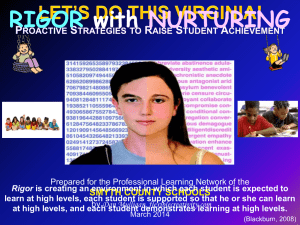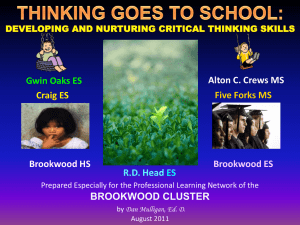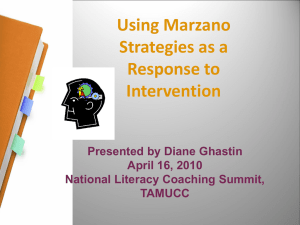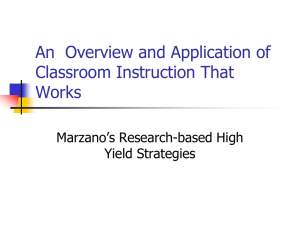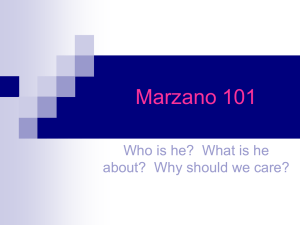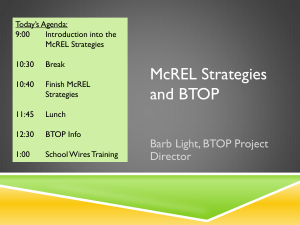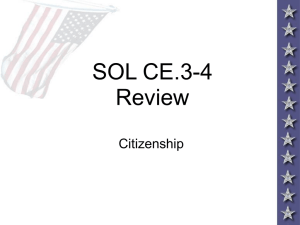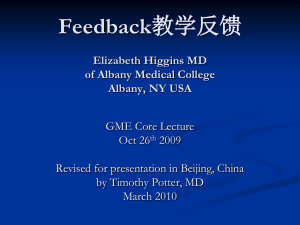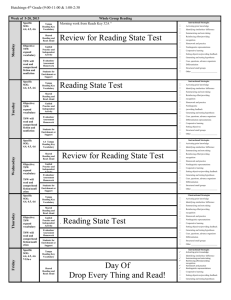I will - Appomattox County Public Schools
advertisement
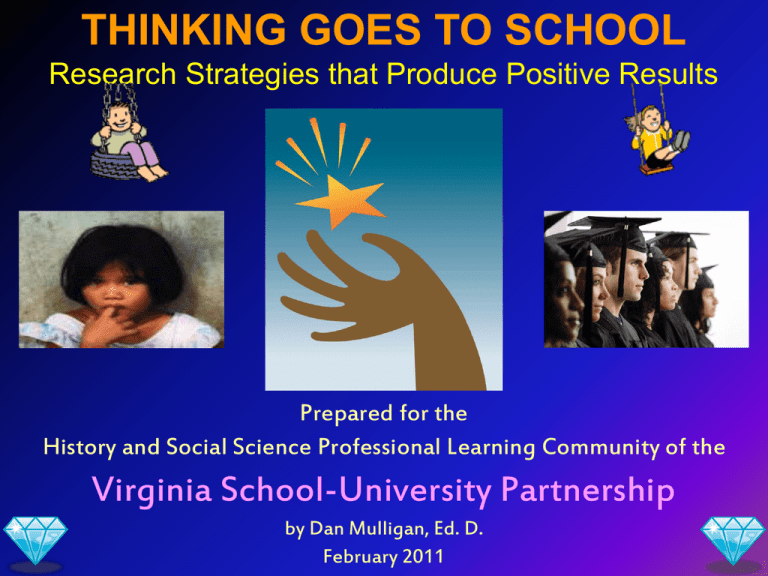
THINKING GOES TO SCHOOL Research Strategies that Produce Positive Results Prepared for the History and Social Science Professional Learning Community of the Virginia School-University Partnership by Dan Mulligan, Ed. D. February 2011 Personal Learning Goals I will recognize the new emphasis on content in the new History & Social Science SOL; I will understand the new emphasis on vocabulary contained in the new History & Social Science SOL; I will identify the new emphasis on skills embedded in the new History & Social Science SOL; I will create learning environments that both build background knowledge and foster reasoning and critical thinking; and I will enjoy working with my colleagues! “Seven Survival Skills for the New Economy” ~Tony Wagner, The Global Achievement Gap 1. 2. 3. 4. 5. 6. 7. Critical Thinking and Problem-Solving Collaboration across Networks and Leading by Influence Agility and Adaptability Initiative and Entrepreneurialism Effective Oral and Written Communication Accessing and Analyzing Information Curiosity and Imagination “Rigor” is using academic knowledge to create new knowledge/ content and to solve real problems. “Engagement” begins with the MIND, not with the HANDS (that is a very loose paraphrase) — activities & action do not equal “rigor” http://epals.com MOVING from ETCH-a SKETCH Learning Don’t let the ‘what’ overshadow the ‘how!’ to Each STUDENT UNDERSTANDING page 2 Opportunity to Learn Has the strongest relationship with student achievement of all school-level factors. What Works in Schools, ASCD Three types of curricula were identified: The Intended Curriculum: content/skill specified by the state, division, or school at a particular grade level. The Implemented Curriculum: content/skill actually delivered by the teacher. The Attained Curriculum: content/skill actually learned by the students. Intended Curriculum Implemented Curriculum Attained Curriculum Content-Related Evidence of Validity (Intended Curriculum) Essential Essential Skills Knowledge Learning TARGET (content validity) Essential Vocabulary Essential Vocabulary Essential Knowledge Essential Skills Explain the meaning of totalitarianism. What factors led to the Holocaust? Compare the genocide of the Armenians and the Tutsis. http://www.nysedregents.org There are three parts to any research-based lesson: •Beginning – ‘check for’ and ‘build’ background knowledge of each student; (BL) •During – teach and actively engage each student in new content – making connections to prior knowledge; (DL) •End – check for understanding provide each student with an opportunity to summarize (in their own way) and practice the essential knowledge and skills conveyed in the lesson. (EL) democracy PAGE 16 SAMPLE Pre-assessment that includes differentiation Mix it Up in the Box Listen for the topic and the amount of time; Silently mix around the room; When directed, pair up with person closest to you; In pairs, Partner A shares and Partner B listens; Partner B responds to what he/she heard by paraphrasing: “LET ME TELL YOU WHAT I UNDERSTOOD YOU TO SAY”; Record summary of partners response; then Switch Roles 1 What is an action taken by you, your grade-level/department or your school that you attribute to resulting in increased understanding of history for each student impacted by the action last year? 3 Look at the picture above. How does this picture relate to your role as a teacher of history? Complete this sentence: The image is like my teaching in that_______ 2 Describe the process currently used to adjust classroom assessments for the new history SOL? What do people ‘do’ with the results? 1 What is an action taken by you, your grade-level/department or your school that you attribute to resulting in increased understanding of history for each student impacted by the action last year? 3 Look at the picture above. How does this picture relate to your role as a teacher of history? Complete this sentence: The image is like my teaching in that_______ 2 Describe the process currently used to create classroom assessments for the new history SOL? What do people ‘do’ with the results? Principle #1 Grounding the Workshop: “Never say anything to a student they can say themselves.” “If you don’t know where you are and you don’t know where you are going, anything you do will get you there” HUNT for SOLUTIONS Record your responses on the smaller Post-it Notes and in a team list… In Virginia’s Public Schools: 1. The % of ALL students scoring Advanced on the Civics and Economics tests in 2010. 35 2. The % of Poverty students scoring Advanced on the Civics and Economics tests in 2010. 19 3. The % of SWD scoring Advanced on the Civics and Economics tests in 2010. 15 4. According to the Silent Epidemic, the % of U.S. dropouts who felt they were ‘too far behind’ by the end of elementary school. 51 5. The % of ALL students Advanced on the VA & US History tests in 2010. 41 6. The % of Poverty students Advanced on the VA & US History tests in 2010. 23 7. The % of SWD students Advanced on the VA & US History tests in 2010. SOLUTIONS: 15, 18, 19, 23, 35, 41, 51 18 1 3 What is an action taken by you, your grade-level/department or your school that you attribute to resulting in increased understanding of history for each student impacted by the action last year? Look at the picture above. How does this picture relate to your role as a teacher of history? Complete this sentence: The image is like my teaching in that_______ 2 Describe the process currently used to adjust classroom assessments for the new history SOL? What do people ‘do’ with the results? When students know what they are learning, their performance, on average, has been shown to be 27 percentile points higher than students who do not know what they are learning. Organizing Student Thinking Category Ave. Effect Percentile Gain Size (ES) Identify similarities & differences 1.61 45 Summarizing & note taking 1.00 34 Reinforcing effort & providing recognition .80 29 Homework & practice .77 28 Nonlinguistic representations .75 27 Cooperative learning .73 27 *Setting objectives & providing feedback* .61 23 Generating & testing hypotheses .61 23 Questions, cues, & advance organizers .59 22 Building Academic Vocabulary Knowledge of important terms is critical to understanding any subject. The more terms a person knows about a subject, the easier it is to understand – and learn – new information related to that subject. Find a new friend in the room. Introduce yourself and share what you ‘do’. Find 2 comfortable seats and relax. WHY ACADEMIC VOCABULARY? Find another 4-second partner Tell them who you are and one summer joy; Find 2 seats. Tell a chain story about the process of photosynthesis… …without using words that begin with: P, L, T, S A Six-Step Process for Teaching New Terms 1: 2: 3: 4: 5: 6: Provide a description, explanation, or example of the new term; Ask students to restate the description, explanation, or example in their own words; Ask students to construct a picture, symbol, or graphic representing the term or phrase; Engage students periodically in activities that will help them add to their knowledge of the terms in their notebooks; Periodically ask students to discuss the terms with one another; and Involve students periodically in games that allow them to play with terms. Research on Imagery as Elaboration Students who used imagery to learn vocabulary, on average, performed # of studies 6 37 percentile pts. higher than… …students who kept repeating definitions. 4 21 percentile pts. higher than… …students who were using the terms in a sentence. Organizing Theme: FAMOUS PEOPLE OF 2010 EDITION Things someone would say… The Queen of England 200 POINTS The Chilean Hillary Coal Miners Clinton 100 POINTS 100 POINTS Sara Palin Mark Zuckerburg Michelle Obama 50 POINTS 50 POINTS 50 POINTS U.S. History: 1865 to Present NATIONALISM 200 POINTS DISCRIMINATION TENEMENTS 100 POINTS 100 POINTS ORGANIZED LABOR 50 POINTS CIVIL LIBERTIES 50 POINTS IMMIGRATION 50 POINTS Great Sites for Images http://etc.usf.edu/clipart/index.htm Elementary Resources: www.greenecountyschools.com Students, Parents Our Schools: Greene County Primary Secondary Resources: http://www.appomattox.schoolfusion.us/ Instruction Curriculum Resources Dan Mulligan 200 POINTS 100 POINTS 50 POINTS 100 POINTS 50 POINTS 50 POINTS Category Ave. Effect Size (ES) Percentile Gain Identify similarities & differences 1.61 45 Summarizing & note taking 1.00 34 Reinforcing effort & providing recognition .80 29 Homework & practice .77 28 Nonlinguistic representations .75 27 Cooperative learning .73 27 Setting objectives & providing feedback .61 23 Generating & testing hypotheses .61 23 Questions, cues, & advance organizers .59 22 Page 19 Summarizing and Note Taking Approaches to this strategy in the classroom: – Teaching students the rule-based summarizing strategies, – Using summary frames, and – Teaching students reciprocal teaching and groupenhanced summary. What does it look like? – Take out material that is NOT important for understanding, – Take out words that repeat information, – Replace a list of things with a word that describes the things in the list (e.g., use trees for elm, oak, and maple). – Find a topic sentence. If you cannot find a topic sentence, make one up. Summarizing and Note Taking Generalizations form the research: – Verbatim note-taking is, perhaps, the least effective technique. – Notes should be considered a work in progress. – Notes should be used as a study guide for tests. – The more notes that are taken, the better. Instructional Strategies that Facilitate Successful Inclusion Must … Supply students with STRUCTURE and ORGANIZATION Encourage student COMMUNICATION and COLLABORATION Provide students with VISUAL and HANDS-ON learning experiences C O V E R Allow students to personalize their notebook with a cover collage. Preserve with packing tape. MIND Notebook Rubric Essential Components of the History and Social Science SOL http://visualblooms.wikispaces.com CUBING 1.Remember it. 2010 (Describe its colors, shapes, and sizes. What does it look like?) 2.Understand it. 3.Apply it. (What does it make you think of?) (What can you do with it? How is it used?) 4.Analyze it. (How is it made or what is it composed of?) 5.Evaluate it. 6.Create it. (Take a stand and list reasons for supporting it.) (Generate a new version of it. How is it an improvement from the original?) Virginia SOL Verbs PROBLEM SOLVING Analyze Predict Discover Survey Evaluate Verify Explore Investigate Compare Explain Hypothesize Validate Contrast Generalize Predict Summarize Differentiate Interpret Infer REASONING Categorize Describe Justify Prioritize Derive Solve Classify Estimate Order Rank COMMUNICATION Clarify Correspond Describe Discuss Demonstrate Exhibit Restate Explain Show Express Speak Persuade State Portray Write KEY QUESTION: Why are common assessments so important? WHY do we ASSESS: 1. INFORM INSTRUCTIONAL DECISIONS 2. ENCOURAGE STUDENTS TO TRY “You can enhance or destroy students’ desire to succeed in school more quickly and permanently through your use of assessment than with any other tools you have at your disposal.” Rick Stiggins, Assessment Trainers Talk to Me… Directions – Form a team of EIGHT (8) people… – Determine the person with the most sisters and then send them to pick-up your team ziplock bag… PLEASE DO NOT OPEN!!! – Determine the person with the least sisters and send them to pick-up a grid sheet for each person. – Distribute a grid sheet to each team member. Follow-up Debriefing Each pair should share with your other team members the method you used to graph the figure. Discuss with your team: – Which method appeals to you? – Is there another method that you would prefer? Prepare for a “pairs choice of method” with a new graph. Key Question Did your performance on the second attempt to complete the grid exercise improve after having an opportunity to self-assess your initial strategy? Formative Assessment Formative assessment is the process used by teachers and students during instruction that provides feedback to adjust teaching and learning for the purpose of improving student learning. Council of Chief State School Officers, October 2006 Notes: Process rather than a particular test…. It is not the nature of the test itself that makes it formative or summative…it is the use to which those results will be put. Thank you for your commitment to children! "It's your attitude, not just your aptitude that determines your ultimate altitude." --Zig Ziglar Dan e4ae.com BLIND SEQUENCING HIGH-Yield Instructional Strategies Category Ave. Effect Size (ES) Percentile Gain Identify similarities & differences 1.61 45 Summarizing & note taking 1.00 34 Reinforcing effort & providing recognition .80 29 Homework & practice .77 28 Nonlinguistic representations .75 27 Cooperative learning .73 27 Setting objectives & providing feedback .61 23 Generating & testing hypotheses .61 23 Questions, cues, & advance organizers .59 22 Effective Instruction #1: consistently uses collaborative learning Group Work Collaborative Learning Looks Like Each student has the same information as every other team member. Each student has unique information necessary for the team to compete the task. I know that George Washington was a brave leader of soldiers. Each student has the same role as every other team member. Each student has a unique role My task is to lead the group in the group. map that will illustrate the location of major events in George Washington’s life. Jigsaw is not needed since each team member can work independent of others and still accomplish the task. Jigsaw can be used to build student understanding of their unique role in the group. During the activity, I will meet with the member from each group that shares my role of mapmaker and we will discuss strategies. Students develop own understandings and solutions. Students work jointly to develop understandings and solutions. Turn to your neighbor and decide what is the most important contribution of George Washington. Imagine yourself living in Name a region of Virginia. the region. In what occupation would you or a family member be employed? Explain? Tell a resource found in this region. Close your eyes and imagine yourself in the region. Describe what your mind visualizes that makes the region distinct. Reflect on Your Strengths and Opportunities to Improve When Working With Others Principle #1 Grounding the Workshop: “Never say anything to a student they can say themselves.” Category Ave. Effect Percentile Gain Size (ES) Identify similarities & differences 1.61 45 Summarizing & note taking 1.00 34 Reinforcing effort & providing recognition .80 29 Homework & practice .77 28 Nonlinguistic representations .75 27 Cooperative learning .73 27 *Setting objectives & providing feedback* .61 23 Generating & testing hypotheses .61 23 Questions, cues, & advance organizers .59 22 Knowing the Learner Directions: Rank the symbols (1-4) in order from most (1) like you as a learner to least (4) like you as a learner. Learning Style of Beach Balls Experimentation Risk taking Adventurous Intuitive/Insightful Creative Spontaneous Attitudes Don’t like step-by-step directions React to internal and external rewards Want to improve things for society Needs Guidelines Boundaries Expectations Standards Parameters Help in Focusing Preferences Stimulus-rich environment Options and alternatives Interesting and exciting learning Knowing the Learner Strengths Learning Style of Microscopes See the big picture Home in on main points Learn from lecture and reading Think in abstract terms and language Analyze theories and information Thorough logical learners Can delay gratification Attitudes Don’t like to waste time “pooling ignorance” Don’t like inquiry Needs Help in working with others Help in organizing time and bringing closure Preferences Vicarious learning Simulations Analytical thinking Expert information Feedback that will improve grades Knowing the Learner Strengths Learning Style of Clipboards Precision and accuracy Striving for perfection Practicality Compliance with teacher Sensory responsive Externally motivated Delay gratification Attitudes No news is good news Serious about their work Require feedback Needs Real experiences Concrete examples, not theory Structure Procedures, routines Directions Preferences Precise, useful feedback Recommendations Appreciate privacy Knowing the Learner Strengths Learning Style of Puppies Empathic Intuitive Subjective, abstract, affective Read between the lines See the gestalt Attitudes Internal motivation Self-monitoring toward personal criteria Require rationale for learning Can block out stimuli Needs Opportunities to work with others Time for self-reflection To connect with teacher and peers Rationale for learning Preferences Subjective versus abstract Personal incentives, encouragement Choice of learning environments Knowing the Learner Strengths “If an educator keeps using the same strategies over and over and the student keeps failing, who really is the slow learner?” Musical/Rhythmic Sing it Create a beat Rap it Make a cheer Create a jingle Hum it Identify sounds React to sounds Listen to sounds Connect to music Write a poem Verbal/Linguistic Read it Spell it Write it Listen to it Tell it Recall it Use “you” words Apply it Chunk information Say it Use mnemonics Logical/Mathematical Make a pattern Chart it Sequence it Create a mnemonic Analyze it Think abstractly Think critically Use numbers Prove it Interpret the data Use the statistics Body/Kinesthetic Role play Walkabout Dance Lip sync Skits/charades/mimes Construction Math manipulatives Sign language Sports Activity centers Body language Intrapersonal Metacognition Use self-talk Work independently Solve in your own way Understand self Journal it Rehearse it Use prior knowledge Connect it Have ownership Interpersonal Think-Pair-Share Jigsaw Cooperative grouping Drama Debates Class meetings Role play Meeting of minds Peer counseling Tutors/buddies Giving feedback Shared Journals Visual/Spatial Mind maps Graphic organizers Video Color code Highlight Shape a word Interpret a graphic Read a chart Study illustrations Visualize it Make a chart Create a poster Naturalist Label it Categorize it Identify it Form a hypothesis Do an experiment Adapt it Construct it Classify it Investigate it Discern patterns Choice Board or Tic-Tac-Toe Choice Board or Tic-Tac-Toe Verbal/Linguistic Body/Kinesthetic Visual/Spatial Wild Card Musical/Rhythmical Intrapersonal Your choice after getting the approval of the teacher. Interpersonal Naturalist Logical/Mathematical Kinds of Evidence – Continuum of Evidence Informal Check for Understanding Imagine yourself living in Name a region of Virginia. the region. In what occupation would you or a family member be employed? Explain? Tell a resource found in this region. Close your eyes and imagine yourself in the region. Describe what your mind visualizes that makes the region distinct. Effective Instruction #2: focuses on essential knowledge and essential skills Three types of curricula exist in any classroom: The Intended Curriculum: content/skill specified by the state, division, or school at a particular grade level. The Implemented Curriculum: content/skill actually delivered by the teacher. The Attained Curriculum: content/skill actually learned by the students. Intended Curriculum Montana Content Standards and PerformanceDescriptors Implemented Curriculum Attained Curriculum Content-Related Evidence of Validity (Attained Curriculum) Essential Essential Skills & Processes Knowledge LEARNING TARGET (attained curriculum) Essential Vocabulary True learning is figuring out what you already know in order to go beyond what you already think. Jerome Bruner The Power of Student Self-assessment to Refine Teacher Craft Find a new friend in the room. Introduce yourself and share what you ‘do’. Find 2 comfortable seats and relax. BRAIN BREAK Select Team Leaders DO OR
